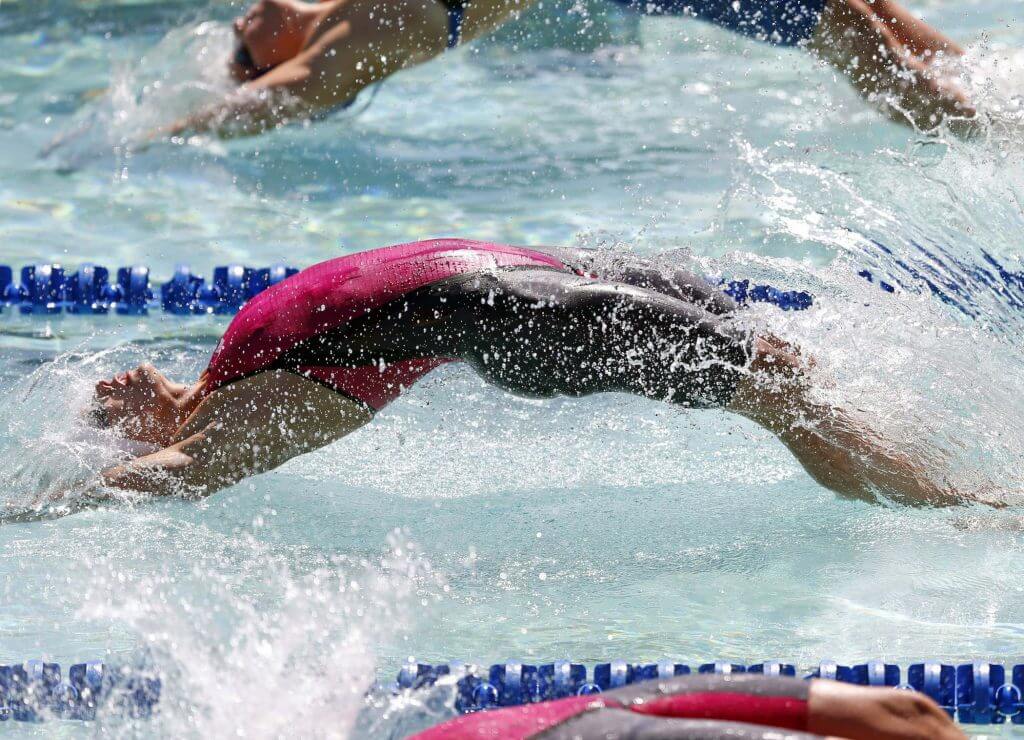Tech Tuesday: 10 Ways to Increase the Life of Your Racing Suit

Suiting Up
1. Cut your nails.
Long sharp nails can easily tear and fray fabric, (not to mention leaving some accidental gashes in your crowded warmup lane mates). Short nails allow you to pull on your suit efficiently without the risk of tearing or snagging the material.
2. Use a light body oil to alleviate stretching the suit over tight areas.
Rather than rolling and bunching the speed suit in attempt to get it over areas like the hips and butt, try applying a light amount of lotion or body oil. Rub the moisturizing agent fully into the skin and then slide the suit over the area. This trick will prevent chaffing as well as the unnecessary stretching of the speed suit. The same method can be used for muscular arms to prevent redness and pulling at the straps.
Competition
3. Minimize the time that you wear the suit.
The longer the suit is stretched on the body and exposed to chlorine, the shorter the suit’s life. Avoid putting on speed suits way before competition; not only do they wear out, tight suits also contribute to muscle fatigue, tightness, and decreased circulation. Waiting until 15 to 20 minutes before your event will contribute to better performance as well as a longer suit life.
4. Avoid putting on, taking off, and adjusting the suit.
Every time the suit changes position, it is stretched and contorted. To increase longevity, try not to unnecessarily put on and take off the suit. Swimming with the suit partially on may reduce muscle fatigue, but also causes the suit to lose shape. The bottom line: reduce your time in the suit so you don’t need to adjust it as often.
5. Watch where you sit.
Speed suits are built to be super thin and hydrodynamic; they are not built to endure pool decks. Most pool sides are textured and rough to prevent swimmers from slipping when they are wet. While surfaces may seem fine for your skin, your suit is sensitive. To reduce the risk of snags, try siting on a towel or wearing sweats that cover up the suit. Be careful in the pool not to lean up against walls and avoid rubbing the suit on the blocks. A torn or snagged suit cannot be easily repaired.
Post-Competition
6. Rinse the suit in cold water immediately after use.
Rinsing the racing suit in cold water provides two benefits: it encourages the suit to contract to regain its original shape and it eliminates some of the chlorine residues. Ideally, the suit should be rinsed immediately after use and then soaked in a dechlorinating solution when the swimmer returns home or to the hotel room.
7. Invest in some dechlorinating drops.
Chlorine is the primary reason suits break down. While rinsing suits provide an initial reduction in chlorine exposure, dechlorinating drops can provide a tremendous benefit to speed suits. Dechlorinating drops are sold commercially for swimmers or you can buy dechlorinating drops for aquariums (which are usually cheaper). Fill a sink with cold water and add one to two drops of dechlorinating solution. Allow the suit to soak for 10 to 15 minutes and then remove from the solution. Do not rinse the suit after using the dechlorinating solution. Tap water contains a variety of purifiers to make it safe for us to drink, rinsing will just reexpose the suit to chlorine.
8. Towel dry
Avoid ringing out and squeezing suits. Instead, lay your dechlorinated suit on a dry towel. Fold the towel over the suit and lightly pat or walk over the towel. The towel will absorb the majority of moisture from the suit. Then hang both up to dry. Avoid hanging suits in hot, humid, or sunny environments. All of these conditions will deteriorate the suit.
9. Give each suit at least 24 hours between wears.
Increasing the amount of time between wears allows the suit to maintain its shape and reduces decomposition. If you are waiting 24 hours, the suit can remain in its hanging area. If the suit will not be worn for an extended period, see below.
10. Store the suit properly.
A racing suit needs to be stored properly just like any other piece of equipment. For ideal results, keep your suit in a separate sealed plastic bag (gently folded if necessary). The sealed plastic bag will stop dust and impurities from degrading the suit. Avoid environments that have extreme temperatures, UV rays, and moisture.




Ashley Hernandez
Read this !
Cindy Bertelink…..we’re going it all wrong. ?
hi,can any1 help me in frog style swimming,unable to do it,,,,as i m a beginner
Hi Smriti. I am a swim instructor. My best advice is check out your local pool for swim lessons.
thanku so much for reply….but the problm is coach is not gud there….they know how to do….but they r unable to make me undrstand the trick or technique…..
Is there another pool you could go to? Or ask for a different instructor?
i m living in a small city…so dont have many options…may be….in future….i will have a gud coach….
thanku so much to reply….so nice of u
Thanks Tracy for the info
Cindy Bertelink…..we’re doing it all wrong. ?
That explains things!
Emma nr2!!!!!
My life has been a lie
Emma Marcus vi måste testa srsly ?
Yaass
Cai Lin Welson Sim
Too bad there’s no 24hrs in between races for the suit to dry. Lol
Haha.. expectation vs reality =P
amazing Sara Youssef
Leslie Garcia -.-
Pauline Tang, Vivian Chow
Dani Cunningham
Brenda Roger Orona
Gabby Jeffers
Grant Wertz
Bulado Swim Club
Sophie
Brittany Archer
Ellie Jones
Nancy Millan
I will keep that in mind ?